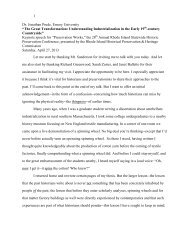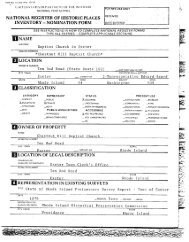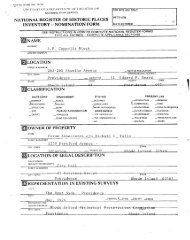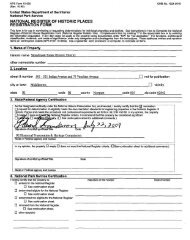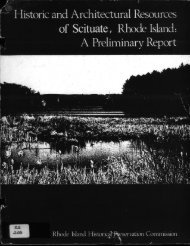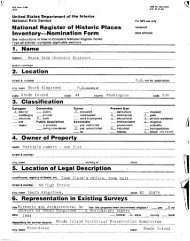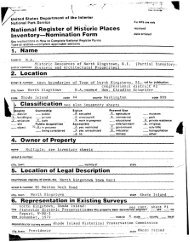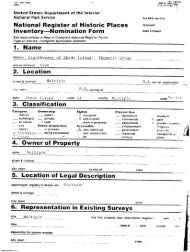National Register of Historic Places - Rhode Island Historical ...
National Register of Historic Places - Rhode Island Historical ...
National Register of Historic Places - Rhode Island Historical ...
Create successful ePaper yourself
Turn your PDF publications into a flip-book with our unique Google optimized e-Paper software.
NP S ‘0,,.. II 900<br />
United States Department <strong>of</strong> the Interior -<br />
<strong>National</strong> Park Service<br />
<strong>National</strong> <strong>Register</strong> <strong>of</strong> <strong>Historic</strong> <strong>Places</strong><br />
Inventory--Nomination Form<br />
Continuation sheet 58 Item number 8<br />
- OMI No ‘024-00,11<br />
Fip t031-04<br />
coy NPS us, only -<br />
received - - - - - - - -<br />
date entered<br />
Though tine Everett Farm was less than half built up at the turn <strong>of</strong><br />
the century, other opportunities for building cottages were opened as well.<br />
in 1896 William A. Procter and William P. Anderson <strong>of</strong> Cincinnati acquired<br />
the Potter Farm, northeasterly <strong>of</strong> the--Syndicate Line the northeasterly<br />
border <strong>of</strong> the Everett Farm on the northerly side <strong>of</strong> Westerly Road. The<br />
old Potter farmhouse was converted into a guest house, subsequently known<br />
as the Misquamicut Inn, arid the acreage was divided into house lots. Some<br />
time later Stanton S. Pendleton subdivided his property, across Westerly<br />
Road from the Potter Pa run. In both sectio ns the new streets were laid out<br />
along curvilinear paths that continued the Everett Farm development. -<br />
The Watch Hill Chapel Society was incorporated in 1875<br />
nent summer - residents. The foLlowing year- George M. Nash,<br />
the Ocean House, gave the society a lot across the street f<br />
A chapel building designed by George Keller <strong>of</strong> Hartford was<br />
the site i.n 1887-. It was a union chapel which houses interd<br />
Protestant- services conducted by visiting clergymen, as well<br />
masses and separate services foi black servants. The Modern<br />
edifice was enlarged in 1902 following the original style <strong>of</strong><br />
and was completely refurbished into a neo-Colonial structure<br />
chapel remains an important center <strong>of</strong> community life today.<br />
Page 5<br />
As the seasonal population <strong>of</strong> Watch Hill swelled various facilities<br />
and services were created that catered to the summer inhabitants. in<br />
general, institutions that met the needs <strong>of</strong> both hote 1 visitors and cottagers<br />
were founded earlier, such as the chapel society. As the number <strong>of</strong> cottagers<br />
grew, organizations arose that we-re more closely related to their way <strong>of</strong><br />
life, such as the country club and yacht club.<br />
by forty promi<br />
proprietor <strong>of</strong><br />
rom his hotel.<br />
completed on -<br />
enominational<br />
as Catholic<br />
Gothic chapel<br />
the building,<br />
in 1928. The<br />
A commercial district evolved along Bay Street. It included dry-goods<br />
and specialty shops, restaurants and lunch ro outs, and provisions stores<br />
that supplied the cottage colony. in 1879 a traveling carnival eft behind<br />
a -flying-horse carodsel which became a fixture at the end <strong>of</strong> Bay Street,<br />
an isolated incident that provided the village- with what is perhaps its<br />
best known landmark. The commun i. ty was subs tantia I enough to ‘a rrant<br />
establnshnnent <strong>of</strong> a post <strong>of</strong> ice here in 1883. A trolley line, the Pawcatuck<br />
Valley Street Railway, was completed in 1894, linking Watch Hill to Westerly<br />
center. This :mptovement was apparently promoted to Westerly businessmen<br />
who sought to draw customers froth the are-n. Many Watch I-fill residents<br />
considered the trolley a nuisance that obstructed carriage--and later<br />
auto--traffic on the Westerly Road. They also feared that steamer service<br />
from Stonington would he discontinued, forcing them to make less convenient<br />
train connections through Westerly station via the trolley. The street<br />
railway operated summers until 1921, when it was discontinued.<br />
See Continuation Sheet #59







